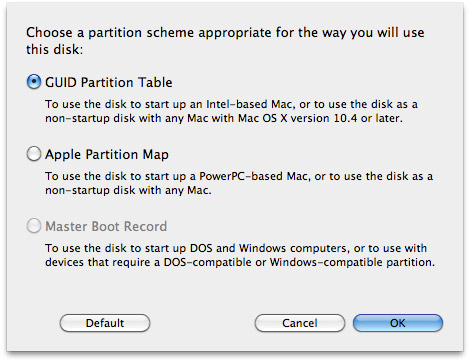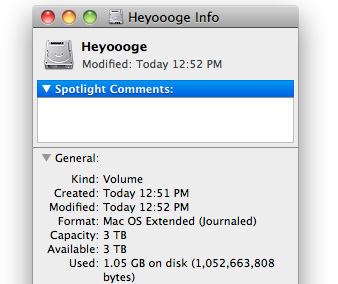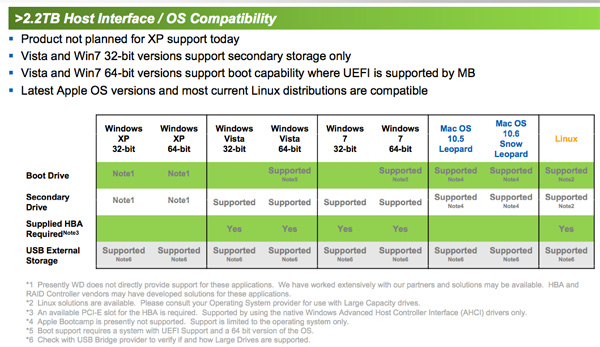Western Digital Caviar Green 3TB and My Book Essential 3TB Drives Reviewed
by Anand Lal Shimpi on October 19, 2010 1:43 PM EST- Posted in
- Storage
- HDDs
- Western Digital
- 3TB
The 2.19TB Barrier
I addressed this in my 3TB Seagate review back in August, so much of this is a rehash from the review back then with some new information toward the end of the page.
Pretty much all HDDs (and SSDs) are addressed using a scheme called Logical Block Addressing (LBA). The method is very, well, logical. Storage is addressed linearly, regardless of how the hardware itself is accessed. You start at LBA 0 and you go all the way up to the last address in your device.
The number of LBAs you can address is a function of your hardware and the style of partition you’ve applied to your drive.
Master Boot Record partitioning is by far the most common on PCs today. LBA 0 contains the Master Boot Record (MBR) and your BIOS looks at the contents of LBA 0 to determine how to boot.
Now LBAs under MBR partitions are addressed using 32-bit values, the maximum of which is 2^32 or 4294967296. Each LBA on a hard drive corresponds to a 512-byte sector value (even on 4K advance format drives, they still appear as 512-byte sector drives to the OS), so the largest partition you can have in a MBR partitioned drive is 4294967296 * 512-bytes or 2,199,023,255,552 bytes.
Hard drive manufacturers define 1TB as 1 trillion bytes. If we use that definition then the largest 32-bit MBR partition would be 2.199TB (2,199,023,255,552 bytes / 1,000,000,000,000). If we define 1TB as 1024^4 bytes (TiB) then the largest 32-bit MBR partition would be 2TiB (2,199,023,255,552 bytes / 1,099,511,627,776). Either way, with a 3TB drive there’s no way we’re getting a single 3TB partition using MBR.
In use on all Itanium and Intel based Macs (among other systems) is GPT (GUID Partition Table), and a feature of GPT is 64-bit LBA support.
With 64-bit LBAs the largest 512-byte sector drive we can address is 9.4ZB (Zettabytes - 10^21 or 2^70 bytes depending on if you’re counting in base 10 or 2). That’s an absurd amount of data.
GPT drives are supported as data drives in all x64 versions of Windows as well as Mac OS X and Linux. Below we have some screenshots of creating a GPT drive in Windows and OS X:

GPT Partition in Windows 7

GPT in Mac OS X
You’ll note that I said data and not boot drives. In order to boot to a GPT partition, you need hardware support. I just mentioned that your PC’s BIOS looks at LBA 0 for the MBR. Your BIOS does not support booting to GPT drives. GPT is however supported by systems that implement the successor to the BIOS: Intel’s Extensible Firmware Interface (EFI).
Intel based Macs don’t use a BIOS and instead have an EFI which allows them to boot to GPT drives. Most PC motherboards however do not have EFI support, and those that do may have bugs associated with the implementation.
I’m expecting to see the first round of motherboards with official 3TB HDD support in the coming weeks. Although consumers shouldn’t expect good support from motherboard makers until the first half of next year. Users of older boards may be out of luck as enabling EFI is still a low priority for most manufacturers.
BIOS support is only part of the problem. You SATA controller also needs to support 64-bit LBAs. Currently Intel’s storage drivers don’t support 64-bit LBAs. Running your ICH in Native IDE mode will work however.
AMD’s 8-series storage drivers do support 64-bit LBAs but I haven’t seen any AMD motherboards with EFI support.
In order to deal with all of the potential controller issues today, Western Digital bundles all 3TB drives with a HighPoint Rocket 620. The controller supports booting to a 3TB formatted drive if your motherboard has EFI support. But as I just mentioned, proper EFI support is tough to come by.

Western Digital expects that we’ll see both motherboard and storage controller support by Q2 2011, at which point it will stop shipping the HighPoint cards with 3TB drives.
The HighPoint adapter uses a Marvell 88SE9025 6Gbps SATA controller, although for some reason installing HighPoint’s drivers on the card (both at boot and under Windows) would cause the drive to disappear entirely. I had to rely on the drivers that ship with Windows 7.
Mac & Linux Support
Intel Macs already ship with EFI support so these drives should just work in a Mac. I popped one into a Nehalem Mac Pro and I confirmed it worked:

Linux is also covered if your distribution enables support for 64-bit LBAs. The full compatibility matrix is below:











48 Comments
View All Comments
mapesdhs - Wednesday, October 20, 2010 - link
I've been buying Samsung drives for a while, they are indeed pretty quick. I've
not compared to Seagate or WD, but I've added some Samsung HDTach data to
my benchmarks page for the 1TB editions of the Spinpoint F1 and F3, if it's of
any use:
http://www.sgidepot.co.uk/diskdata.html
At some stage I'd like to start testing random read/write with IOMeter, but finding
the time is a problem.
Ian.
EddyKilowatt - Tuesday, October 19, 2010 - link
Exactly. I think the fast/high performance end of the magnetic storage market will wither pretty fast under the onslaught of SSDs, except for increasingly niche applications that need fast access to 500-1000 MB of data.Meanwhile, as SSDs get solidified in the fast boot/app/cache role, the need for speed will further be relaxed for these big TB-class drives, and disk builders will feel freer to optimize for areal density at the expense of speed. I think we'll see lots of 5400 drives, and who knows... maybe 4200 and other speeds that till now have seemed like grandma territory. Anything that can originate a couple of full-HD video streams, or other media stream of your choice, seems like it ought to be viable for what will increasingly be the foundation tier of the ever-diversifying storage hierarchy.
AFUMCBill - Tuesday, October 19, 2010 - link
"The Essential suffix somehow implies USB 3.0 support."This is incorrect. The Essential suffix means USB only support, no eSATA, no FireWire. That USB support can be either USB 2.0 or USB 3.0.
kepstin - Tuesday, October 19, 2010 - link
It's not actually true that a classic PC BIOS can't boot from a GPT formatted disk - I'm doing that right now!The design of GPT incorporates backwards compatibility, including space for an old-fashioned MBR boot sector that can be loaded with a bootloader that knows how to read GPT. As a result, Linux boots just fine on a GPT partitioned disk, even on a classic BIOS PC.
The issue is specifically that Windows can't boot off of a GPT disk without EFI, because the boot loader that Windows uses on a BIOS machine doesn't know how to read GPT partitions.
Mr Perfect - Wednesday, October 20, 2010 - link
Can it read more then 2TB? I read it to mean that BIOS couldn't handle anything bigger then 2TB, regardless.Etern205 - Wednesday, October 20, 2010 - link
On page 2 , one of the images show a MBR partition HDD can be converted to GPT.If one has all the requirements, can they just use their OS disc to directly create a GPT partition instead of doing this conversion stuff?
R3MF - Wednesday, October 20, 2010 - link
Anand - will there be 2TB green drives based on these platters?tiro_uspsss - Wednesday, October 20, 2010 - link
there is no 150GB VelociRaptor in the benches/review.. ;)mapesdhs - Wednesday, October 20, 2010 - link
Here's what I get with HDTach for my WD VR 150GB:
Max: 132.0 MB/sec
Avg: 107.0 MB/sec
Min: 79.0 MB/sec
Burst: 248.0 MB/sec
Access: 6.9ms
Ref: http://www.sgidepot.co.uk/diskdata.html
What does IOMeter use as its definition of 1MB? 10^6 bytes or 2^20 bytes? I think
HDTach uses the former.
Ian.
Mr Perfect - Wednesday, October 20, 2010 - link
I've seen a number of sites now mentioning UEFI will show up in H1 of 2011. Is UEFI an official feature of the Cougar Point chipsets?